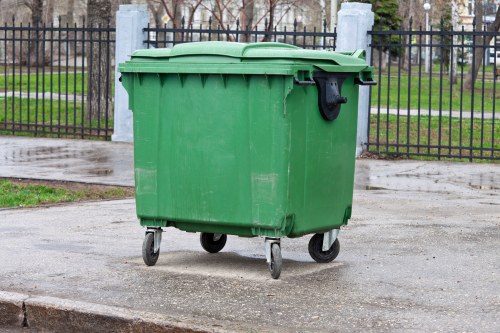Efficient Furniture Disposal in Disposal London: Your Comprehensive Guide
Understanding Furniture Disposal

Furniture disposal is a common necessity for both homeowners and businesses in London. Whether you're upgrading your living space, relocating, or simply decluttering, knowing how to effectively dispose of unwanted furniture is essential.
Improper disposal can lead to clutter, environmental harm, and even legal issues in some cases. By understanding the best practices for furniture disposal, you can ensure that your items are handled responsibly and efficiently.
In London, there are various options available for furniture disposal, each catering to different needs and preferences. From donation centers to recycling facilities, choosing the right method depends on several factors including the condition of the furniture and your personal circumstances.
Why Proper Furniture Disposal Matters

Proper furniture disposal plays a significant role in environmental conservation. Many pieces of furniture can be recycled or repurposed, reducing the strain on landfills and minimizing the carbon footprint associated with manufacturing new items.
Additionally, responsible disposal ensures that potentially hazardous materials, such as certain finishes or electronics integrated into furniture, are handled safely.
Moreover, local regulations in London may have specific requirements for disposing of large items like furniture. Being aware of these can help you avoid fines and ensure compliance with city laws.
Options for Furniture Disposal in London

When it comes to disposing of furniture in London, you have several viable options:
- Donation Centers: Organizations like the British Heart Foundation or local charities accept gently used furniture, providing them with a second life.
- Recycling Facilities: For furniture that’s no longer usable, recycling centers can break down materials for reuse, ensuring minimal environmental impact.
- Bulk Waste Collection: The local council offers bulk waste collection services for large items, though scheduling and fees may apply.
- Junk Removal Services: Professional junk haulers provide convenient and efficient removal, often handling all the logistics for you.
Each option has its own set of benefits, and the best choice depends on your specific needs and the condition of your furniture.
Step-by-Step Guide to Furniture Disposal

Disposing of furniture in London can be straightforward if you follow these steps:
- Assess the Condition: Determine whether the furniture is in good condition, needs repairs, or is beyond repair.
- Choose the Right Disposal Method: Based on the assessment, select the most appropriate disposal option.
- Prepare the Furniture: Clean the items and dismantle them if necessary to facilitate easier handling.
- Arrange for Collection or Drop-Off: Contact the chosen disposal service to schedule a pickup or find a suitable drop-off location.
- Follow Up: Ensure that the furniture has been properly disposed of or recycled, keeping records if needed for future reference.
Benefits of Using Professional Disposal Services

Opting for professional furniture disposal services in London offers numerous advantages:
- Convenience: Professionals handle all aspects of the disposal process, saving you time and effort.
- Efficiency: Experienced services can quickly and safely remove large or cumbersome items.
- Compliance: Ensure that disposal methods adhere to local regulations and environmental standards.
- Safety: Reduce the risk of injury by allowing experts to handle heavy or awkward furniture pieces.
- Eco-Friendly: Many professional services prioritize recycling and donating, contributing to sustainability.
Choosing a trusted disposal service can simplify the process and provide peace of mind knowing that your furniture is handled responsibly.
Tips for Sustainable Furniture Disposal
Embracing sustainability in furniture disposal not only benefits the environment but also supports community initiatives. Here are some tips to ensure your disposal practices are eco-friendly:
- Donate Wisely: Ensure that donated items are clean and in good condition to maximize their reusability.
- Recycle Materials: Separate recyclable components like metal, wood, and glass to facilitate proper recycling.
- Repurpose Furniture: Get creative and find new uses for old furniture, giving it a fresh life in your home or garden.
- Reduce Waste: Before disposing of items, consider if they can be repaired or updated to extend their lifespan.
- Choose Eco-Friendly Services: Select disposal services that prioritize sustainability and environmentally friendly practices.
Implementing these strategies can significantly reduce the environmental impact of furniture disposal and promote a more sustainable lifestyle.
Cost Factors in Furniture Disposal
Understanding the cost factors involved in furniture disposal can help you make informed decisions and budget appropriately. Several elements influence the overall cost:
- Size and Volume: Larger and bulkier items typically incur higher disposal fees due to the increased effort and resources required.
- Service Type: Professional removal services may charge based on the complexity and time needed for disposal.
- Location: Disposal costs can vary depending on your specific area within London and the availability of services.
- Condition of Furniture: Items that require special handling or recycling may come with additional costs.
- Scheduling: Emergency or same-day services often come at a premium compared to scheduled pickups.
By considering these factors, you can choose a disposal option that aligns with your financial and logistical needs.
Local Regulations and Compliance
Adhering to local regulations is crucial when disposing of furniture in London. The city has specific guidelines to ensure that waste management practices are effective and environmentally responsible.
- Waste Classification: Furniture is typically classified as bulky waste, which has designated disposal protocols.
- Collection Schedules: London boroughs may have specific collection days and procedures for large items.
- Permits and Fees: Certain types of disposal may require permits or incur fees, especially for large quantities or specific materials.
- Recycling Requirements: Some regulations mandate the recycling of particular materials found in furniture to minimize environmental impact.
- Illegal Dumping Penalties: Unauthorized disposal of furniture can result in hefty fines and legal consequences.
Staying informed about these regulations ensures that your furniture disposal process is compliant and avoids potential legal issues.
Choosing the Right Disposal Service in London
Selecting the appropriate furniture disposal service in London requires careful consideration of several factors to ensure efficiency, reliability, and environmental responsibility.
- Reputation: Research customer reviews and ratings to gauge the reliability and quality of the service.
- Services Offered: Ensure that the provider offers the specific disposal services you need, whether it's recycling, donation, or bulk removal.
- Pricing: Compare quotes from different providers to find a service that fits your budget without compromising quality.
- Licenses and Certifications: Verify that the service is licensed and adheres to local regulations and environmental standards.
- Customer Support: Opt for services that offer responsive and helpful customer support to address any concerns or questions.
By evaluating these aspects, you can make an informed decision and choose a disposal service that meets your needs effectively.
Preparing Your Furniture for Disposal
Proper preparation of your furniture before disposal can streamline the process and enhance the efficiency of the removal service.
- Clean the Items: Remove dirt and stains to make items more appealing for donation or easier to handle for disposal.
- Disassemble if Necessary: Breaking down large furniture pieces can facilitate easier transport and reduce disposal costs.
- Remove Hazardous Components: Take out any parts that may be hazardous or non-recyclable, such as batteries or electronic elements.
- Sort Items: Separate items into categories based on their disposal method, such as recyclable, donation, or waste.
- Label for Clarity: Clearly label items to indicate their contents or required handling, aiding in efficient processing.
These steps ensure that your furniture is ready for disposal, making the overall process smoother and more efficient.
Environmental Impact of Furniture Disposal
The manner in which furniture is disposed of has significant implications for the environment. Improper disposal can lead to increased landfill waste, pollution, and resource depletion.
Conversely, responsible disposal practices such as recycling, repurposing, and donating can mitigate these negative effects by conserving resources and reducing the need for new material production.
Additionally, mindful disposal helps in lowering greenhouse gas emissions associated with manufacturing and transporting new furniture, contributing to broader environmental sustainability goals.
Innovative Disposal Solutions in London
London is home to various innovative solutions aimed at improving the efficiency and sustainability of furniture disposal. These include:
- Smart Recycling Programs: Initiatives that use technology to streamline the recycling process, making it easier for residents to participate.
- Upcycling Workshops: Community events that teach individuals how to repurpose old furniture into new, functional items.
- Eco-Friendly Collection Services: Disposal services that prioritize green practices, such as electric-powered vehicles and eco-conscious processing methods.
- Donation Partnerships: Collaborations between disposal services and charitable organizations to ensure seamless donation and distribution of usable furniture.
- Waste-to-Energy Facilities: Plants that convert non-recyclable furniture materials into energy, reducing landfill waste and generating power.
These innovative approaches enhance the overall effectiveness of furniture disposal, promoting a more sustainable and eco-friendly community.
Common Challenges in Furniture Disposal
Despite the availability of various disposal options, several challenges can complicate the process:
- Space Constraints: Limited space for storing items before disposal can make the process more stressful and rushed.
- Cost Management: Balancing disposal costs with budget constraints can be difficult, especially for large or multiple items.
- Time Constraints: Coordinating schedules for pickup or drop-off services around personal or work commitments requires careful planning.
- Condition of Items: Severely damaged or old furniture may have fewer disposal options, limiting choices to recycling or landfill methods.
- Awareness and Information: Lack of knowledge about available services and regulations can lead to inefficient or illegal disposal practices.
Addressing these challenges involves proactive planning, research, and sometimes seeking professional assistance to navigate the complexities of furniture disposal effectively.
Future Trends in Furniture Disposal
The landscape of furniture disposal is evolving with advancements in technology and growing environmental awareness. Future trends are likely to focus on:
- Enhanced Recycling Technologies: Improved methods for breaking down and reusing materials, making recycling more efficient and cost-effective.
- Digital Platforms for Service Coordination: Online tools and apps that connect individuals with disposal services seamlessly.
- Circular Economy Models: Systems that prioritize reuse and recycling, minimizing waste and promoting sustainable consumption.
- Increased Consumer Awareness: Greater public understanding of the environmental impact of disposal practices, leading to more responsible behavior.
- Regulatory Changes: Stricter laws and guidelines aimed at reducing landfill waste and encouraging sustainable disposal methods.
Staying informed about these trends can help individuals and businesses adapt their disposal practices to align with future sustainability goals.
Conclusion: Making the Right Choice for Furniture Disposal
Effective furniture disposal in London requires a thoughtful approach that considers environmental impact, cost, convenience, and compliance with local regulations. By exploring the available options, preparing your items appropriately, and choosing the right disposal service, you can manage unwanted furniture responsibly and sustainably.
Remember, every piece of furniture has the potential to contribute to a greener future when disposed of correctly. Whether you opt to donate, recycle, or use professional services, your choices play a crucial role in promoting environmental stewardship and community well-being.
Contact us today to learn more about our furniture disposal services in London and make your disposal process seamless and eco-friendly!